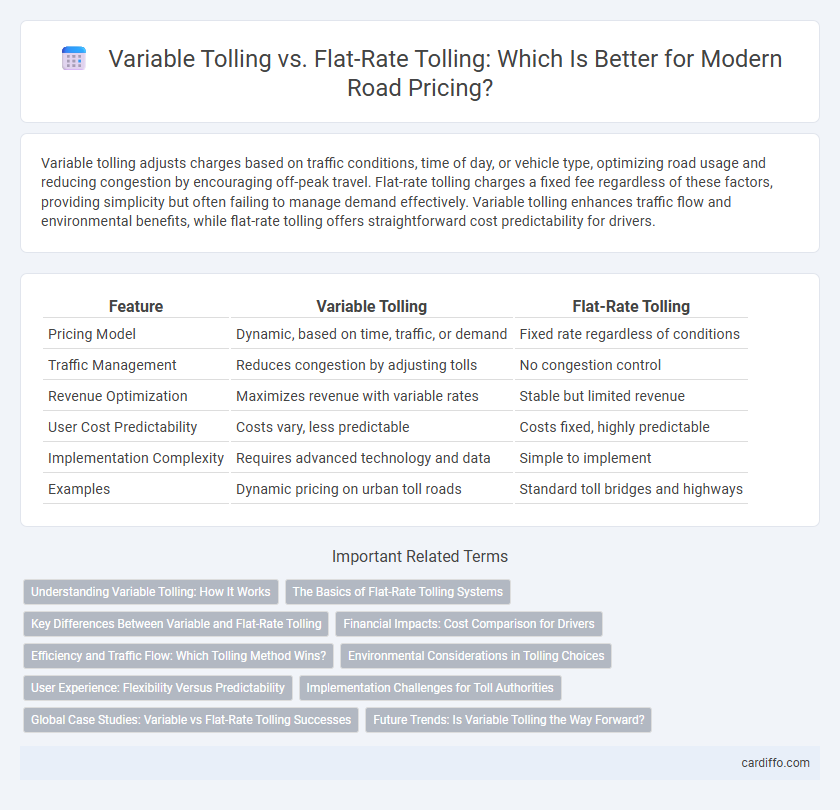Variable tolling adjusts charges based on traffic conditions, time of day, or vehicle type, optimizing road usage and reducing congestion by encouraging off-peak travel. Flat-rate tolling charges a fixed fee regardless of these factors, providing simplicity but often failing to manage demand effectively. Variable tolling enhances traffic flow and environmental benefits, while flat-rate tolling offers straightforward cost predictability for drivers.
Table of Comparison
| Feature | Variable Tolling | Flat-Rate Tolling |
|---|---|---|
| Pricing Model | Dynamic, based on time, traffic, or demand | Fixed rate regardless of conditions |
| Traffic Management | Reduces congestion by adjusting tolls | No congestion control |
| Revenue Optimization | Maximizes revenue with variable rates | Stable but limited revenue |
| User Cost Predictability | Costs vary, less predictable | Costs fixed, highly predictable |
| Implementation Complexity | Requires advanced technology and data | Simple to implement |
| Examples | Dynamic pricing on urban toll roads | Standard toll bridges and highways |
Understanding Variable Tolling: How It Works
Variable tolling adjusts charges based on real-time traffic conditions, time of day, or congestion levels, encouraging drivers to travel during off-peak hours and reducing overall traffic congestion. Sensors and dynamic pricing algorithms monitor road usage and automatically modify toll rates to balance demand and improve traffic flow. This system enhances road efficiency by incentivizing more efficient driving patterns and reducing delays.
The Basics of Flat-Rate Tolling Systems
Flat-rate tolling systems charge a fixed fee regardless of distance traveled or time of day, simplifying payment processes for drivers and operators. This model ensures predictable revenue streams and minimizes administrative costs by eliminating the need for complex monitoring or dynamic pricing technology. Flat-rate tolls are commonly used on bridges, tunnels, and urban express lanes where consistent fees promote ease of use and efficient traffic flow management.
Key Differences Between Variable and Flat-Rate Tolling
Variable tolling adjusts fees based on real-time factors such as traffic congestion, time of day, or vehicle type, optimizing road usage and reducing congestion during peak hours. Flat-rate tolling charges a fixed fee regardless of travel conditions, offering simplicity but lacking flexibility to manage traffic flow effectively. The key difference lies in variable tolling's ability to dynamically influence driver behavior and traffic patterns, whereas flat-rate tolling provides predictable costs without demand-responsive incentives.
Financial Impacts: Cost Comparison for Drivers
Variable tolling adjusts fees based on traffic conditions, time of day, or vehicle type, often resulting in lower average costs for drivers during off-peak hours compared to flat-rate tolling. Flat-rate tolling charges a fixed fee regardless of congestion or time, potentially increasing expenses during non-peak times when road usage is low. Financially, variable tolling can reduce overall driving costs and encourage efficient road use, while flat-rate tolls provide predictable expenses but may lack economic incentives to shift travel behavior.
Efficiency and Traffic Flow: Which Tolling Method Wins?
Variable tolling enhances traffic flow by dynamically adjusting prices based on real-time congestion levels, effectively reducing peak-hour traffic and promoting optimal roadway usage. In contrast, flat-rate tolling lacks flexibility, often leading to inefficient traffic distribution and increased congestion during busy periods. Efficient traffic management overwhelmingly favors variable tolling for its ability to balance demand and maintain smoother traffic movement.
Environmental Considerations in Tolling Choices
Variable tolling reduces traffic congestion and vehicle emissions by adjusting prices based on demand, encouraging off-peak travel and use of eco-friendly transportation. Flat-rate tolling lacks incentives to change driving behavior, often resulting in higher pollution and increased environmental impact. Implementing variable tolling aligns transportation funding with sustainable urban mobility goals and climate change mitigation efforts.
User Experience: Flexibility Versus Predictability
Variable tolling enhances user experience by offering flexibility, allowing drivers to choose travel times based on dynamic pricing that can reduce congestion and save money. Flat-rate tolling provides predictability, giving users a consistent cost regardless of time or traffic conditions, which simplifies budgeting and trip planning. Each method caters to different preferences: variable tolling suits cost-sensitive and time-flexible drivers, while flat-rate tolling appeals to those prioritizing ease and financial certainty.
Implementation Challenges for Toll Authorities
Variable tolling requires advanced traffic monitoring systems and dynamic pricing algorithms, creating significant initial infrastructure costs and technical complexity for toll authorities. Flat-rate tolling simplifies revenue collection but often results in inefficiencies like congestion and suboptimal road usage, posing challenges for long-term traffic management. Implementing variable tolling demands continuous data analysis and system maintenance, stressing organizational resources and requiring robust communication strategies to gain public acceptance.
Global Case Studies: Variable vs Flat-Rate Tolling Successes
Variable tolling systems in cities like Singapore and Stockholm demonstrate significant traffic congestion reduction by adjusting fees based on demand and time of day, enhancing road efficiency and lowering emissions. Conversely, flat-rate tolling in places such as the Golden Gate Bridge in San Francisco simplifies revenue collection but often fails to manage traffic volume effectively, leading to persistent congestion issues. Data from these global case studies reveal that variable tolling consistently outperforms flat-rate models in balancing traffic flow, environmental benefits, and commuter cost fairness.
Future Trends: Is Variable Tolling the Way Forward?
Variable tolling adapts pricing based on real-time traffic conditions, promoting efficient road use and reducing congestion, making it increasingly favored over flat-rate tolling. Advanced technologies like AI and IoT enable dynamic toll adjustments that align with traffic demand, enhancing revenue optimization and environmental benefits. Future trends indicate a strong shift towards variable tolling as urban areas seek scalable, smart infrastructure solutions for sustainable transportation management.
Variable Tolling vs Flat-Rate Tolling Infographic

 cardiffo.com
cardiffo.com